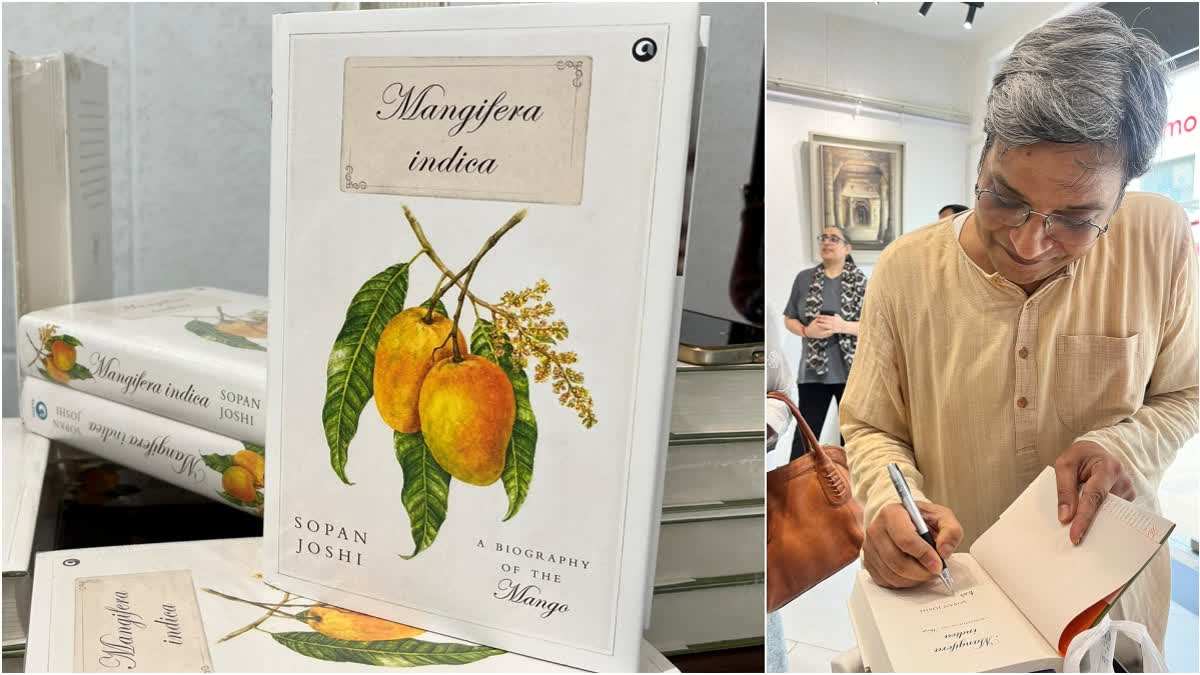In his latest book, Mangifera indica: A Biography of the Mango, published by Aleph Book Company, author and researcher Sopan Joshi offers a rich tapestry of insights drawn from over ten years of research and travel. Joshi recently shared his experiences and passion for both the taste and exploration of mangoes in a conversation with ETV Bharat.
Joshi’s book delves into the lives of those involved with mangoes — whether they grow, sell, eat, research, or simply discuss them. It reveals our deep connection with this fruit, which has captivated us for centuries. The tropical environment, where most fruits deteriorate quickly, plays a significant role in this bond. Unlike more durable fruits like coconuts and pineapples, mangoes — especially those bred for longer shelf life — often lose their unique flavour and aroma.
"In India, where mangoes are incredibly diverse and special, many varieties don't fare well during transport, with the Alphonso being a notable exception. To truly experience the best of India’s mangoes, you need to travel and taste them at their peak," Joshi observed.
Proof of Origin
Consider this: people from the Indus Valley Civilisation were enjoying mangoes over 4,000 years ago! Excavations at a site in Farmana, Haryana, dated around 2600–2200 BCE, reveal evidence of this. Researchers even found remnants of a curry made with brinjal, ginger, turmeric, and mango on ancient kitchen tools in 2010. It's amazing to think that mangoes were being enjoyed so long ago!
According to Sopan Joshi, scientists have discovered a piece of black shale with an imprint of a mango leaf that is about 25 million years old. This discovery suggests that mangoes have an even deeper history than we ever imagined.
Southern vs. Northern Mangoes
Joshi’s book highlights that there’s no universal answer for mango flavours. The distinct taste of each variety is deeply influenced by the soil and climate of its native region. When grown elsewhere, the same variety can taste and look different.
Southern mangoes, with their ideal balance of sugar and acidity, are better suited for travel. In contrast, northern mangoes, which are sweeter, ripen too quickly and don’t last as long. This is why people in North India often prefer southern mangoes. Additionally, organised horticultural practices in southern India help keep the mangoes in better condition, while rough handling in the North can affect their appearance. Seasonal factors also play a role: summer arrives earlier in the South, and the monsoon comes sooner.
How We Grow Mangoes
Joshi explains that mangoes can be grown in two main ways: from seeds or by cloning the parent tree. Planting a mango seed can lead to unpredictable results because mangoes don’t always reproduce consistently. So, if you plant a seed from a mango you love, don’t be surprised if the new tree produces fruit that tastes different — or even completely new.
To achieve more consistent results, horticulturists use a cloning method. They graft a branch from the parent tree onto a sapling grown from a seed. The part below the graft comes from the seed, while the part above is a clone of the parent tree. This ensures that the new tree will produce fruit just like the original.
Joshi also notes that nearly all mangoes found in markets come from these grafted trees, known as ‘kalam.’ This term, borrowed from Arabic, means pen, vegetative shoot, or even sideburns. In the Mithila region of northern Bihar, a grove of these grafted trees is simply called a ‘kalam.’
History of Kalami Aam
When did mango grafting begin? Historians are still piecing together the full story. Goa-born polymath and historian Damodar D. Kosambi suggested in a 1956 book that Jesuit priests may have introduced mango grafting in Goa in the sixteenth century. In a 1946 study, Parashuram Krishna Gode, a Sanskrit and Prakrit scholar, was among the first to address grafting in a modern context. He cited historical references ranging from the sixth-century scholar Varahamihira’s Brihatsamhita to the 1886 glossary Hobson-Jobson. Gode concluded that the art of grafting likely entered Indian horticulture around 1550 and was initially confined to Goa, spreading to places like Madras around 1798, thanks to figures like Clive, the Governor of Madras. British officer Proby Cautley, known for his work on the Upper Ganga Canal, also contributed to the spread of grafted mangoes in the nineteenth century.
The Downside of Mango Ripening
In their haste to ripen mangoes swiftly, many sellers resort to using calcium carbide, a harmful shortcut. This powder, when mixed with moisture, releases acetylene gas that speeds up the ripening process. It makes the mangoes look ripe on the outside, but the inside often remains under-ripe and starchy. So, while the mangoes may appear appetizing, they can end up tasting rather bland.
But there’s more to worry about. Calcium carbide can also damage the fruit’s nutrients and vitamins. Moreover, it often contains impurities like arsenic and other dangerous chemicals, which can contaminate the fruit and pose serious health risks. This can lead to symptoms like vomiting, diarrhoea, and skin irritation, with heightened risks for pregnant women and workers handling these chemicals in unsafe conditions. Animal studies have shown just how harmful calcium carbide can be. In fact, the Food Safety and Standards Authority of India (FSSAI) banned its use for ripening fruit in 2011 due to these health concerns.
At the lower end of the market, some retailers use these dangerous practices to avoid losses. Calcium carbide becomes a last-ditch effort to meet demand, similar to how growers use PBZ and pesticides. This desperation is driven by consumers who want mangoes as early as possible and are willing to pay premium prices. For instance, in March 2022, the first crates of Devgad Alphonso mangoes were auctioned for as much as ₹18,000 to ₹31,000 each in Pune.
Read More



